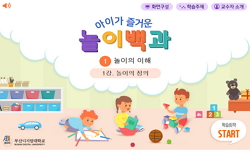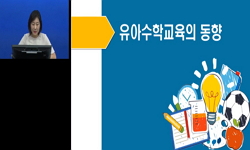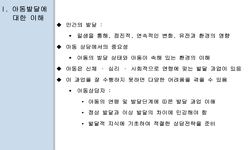본 연구는 일반교실에 소속된 특수유아의 통합교육의 실천적 교수전략으로 발달에 적합한 실제(DAP)의 원리를 적용하였다. 이러한 DAP의 적용은 특수유아를 결손지향적인 존재로 바라보는 시...
http://chineseinput.net/에서 pinyin(병음)방식으로 중국어를 변환할 수 있습니다.
변환된 중국어를 복사하여 사용하시면 됩니다.
- 中文 을 입력하시려면 zhongwen을 입력하시고 space를누르시면됩니다.
- 北京 을 입력하시려면 beijing을 입력하시고 space를 누르시면 됩니다.
https://www.riss.kr/link?id=A103627153
- 저자
- 발행기관
- 학술지명
- 권호사항
-
발행연도
2007
-
작성언어
Korean
- 주제어
-
등재정보
KCI등재
-
자료형태
학술저널
- 발행기관 URL
-
수록면
281-305(25쪽)
-
KCI 피인용횟수
4
- 제공처
- 소장기관
-
0
상세조회 -
0
다운로드
부가정보
국문 초록 (Abstract)
본 연구는 일반교실에 소속된 특수유아의 통합교육의 실천적 교수전략으로 발달에 적합한 실제(DAP)의 원리를 적용하였다. 이러한 DAP의 적용은 특수유아를 결손지향적인 존재로 바라보는 시각에서 벗어나 개별성을 존중하는 철학에서 시작되었다. 연구결과, 일반 교실에는 특수유아가 참여할 수 있는 놀이가 거의 없었지만 DAP 원리를 적용하면서 부분적 또는 온전한 놀이참여가 나타났다. 첫째, DAP의 적용은 특수유아의 발달수준을 인정하는 것부터 시작되었는데, 이는 각양각색의 다양성을 지닌 존재로 보는 시각이 필요하였다. 둘째, 특수유아와 관련된 정보 모으기는 결손지향적인 조사차원이 아니라 특수유아의 흥미나 잘할 수 있는 능력을 찾아내는 것이며, 이는 기본적이면서 중요한 과정이었다. 셋째, 일반유아들이 사용하는 교구를 특수유아에 적합하도록 부분적으로 수정함으로써 특수유아들은 친숙하게 놀이에 참여하였다. 넷째, 특수유아에게도 일반유아와 똑같은 동등한 기회를 준다면 놀이의 참여는 증가하였다. 다섯째, 특수유아들에게는 쉽고 단순한 것을 단계적으로 진행하도록 하는 장기전이 필요하였다. 여섯째, 특수유아에게 매우 강력한 힘을 가지고 있는 교사의 상호작용은 지시적 뿐만 아니라 비지시적인 연속성이 필요하였다. DAP의 구성요소인 놀이중심, 개별성, 흥미, 적극적 탐색, 자발성의 원리는 특수유아들에게도 적용이 가능하였고, 이를 특수유아 통합교육을 실현하는 원리로 적응할 것을 주장하였다.
다국어 초록 (Multilingual Abstract)
This study applied the Developmentally Appropriate Practice (DAP) for Inclusion of children with special needs in the general classroom. DAP came from philosophy that children with special needs survival skills are important. The result of this stu...
This study applied the Developmentally Appropriate Practice (DAP) for Inclusion of children with special needs in the general classroom. DAP came from philosophy that children with special needs survival skills are important.
The result of this study was as follows:
Generally, children with special needs hardly participated in play in the general classroom environment. However, children with special needs could partly or wholly participate in play by DAP educational theory.
First of all, applying DAP started with admitting children with special needs. Second, collecting special needs children with positive interests and good skills was important to make strong power for the Inclusion. Third, friendlier children with special needs were included in the general environment with general teaching and play material adjusted for the children with special needs. Fourth, differentiation and equivalence had different meanings for the children with special needs. Fifth, children with special needs needed long term processes with easy and simple levels. Sixth, interactions between teacher and children with special needs required direct and indirect continuity.
DAP's structural elements such as play oriented, individual, interests, progressive searching, and spontaneity theory could apply to children with special needs and it realizes children with special needs Inclusion.
목차 (Table of Contents)
- Ⅰ. 서론
- Ⅱ. 연구방법
- Ⅲ. 연구결과 및 해석
- Ⅳ. 결론 및 제언
- 참고문헌
- Ⅰ. 서론
- Ⅱ. 연구방법
- Ⅲ. 연구결과 및 해석
- Ⅳ. 결론 및 제언
- 참고문헌
- Abstract
참고문헌 (Reference)
1 조윤경, "통합환경의 장애 및 일반 유아들의 행동 형태 및 이에 영향을 미치는 생태학적 변인에 대하 분석: 환경-행동적 평가를 중심으로" 21 (21): 155-184, 2001
2 유수옥, "장애유아 통합교육의 성공적 실천의 방해요인에 관한 연구" 22 (22): 111-132, 2002
3 백경순, "유아교사와 유아특수교사가 특수유아 통합교육에서 직면하는 어려움에 관한 연구" 한국영유아교원교육학회 9 (9): 193-214, 2005
4 Hohman, M., "Young children in action: A Manual for preschool educators" High/Scope 1979
5 Erwin, E., "What preschool teachers do when children play" 1993
6 Council for Exceptional Children, "What every special educators must know: The international standards for the preparation and certification of special education teachers" Council for Exceptional Children 1996
7 Linder, T., "Transdisciplinary play-based assessment" Paul H. Brookes 1990
8 Klein, D. D., "Strategies for including children with special needs in early childhood settings" Delmar 2001
9 Berk, L. E., "Scaffolding children's learning Vygotsky and early childhood education" National Association for the Education of Young Children 1995
10 Patton, M. Q., "Qualitative evaluation and research method" Sage 1990
1 조윤경, "통합환경의 장애 및 일반 유아들의 행동 형태 및 이에 영향을 미치는 생태학적 변인에 대하 분석: 환경-행동적 평가를 중심으로" 21 (21): 155-184, 2001
2 유수옥, "장애유아 통합교육의 성공적 실천의 방해요인에 관한 연구" 22 (22): 111-132, 2002
3 백경순, "유아교사와 유아특수교사가 특수유아 통합교육에서 직면하는 어려움에 관한 연구" 한국영유아교원교육학회 9 (9): 193-214, 2005
4 Hohman, M., "Young children in action: A Manual for preschool educators" High/Scope 1979
5 Erwin, E., "What preschool teachers do when children play" 1993
6 Council for Exceptional Children, "What every special educators must know: The international standards for the preparation and certification of special education teachers" Council for Exceptional Children 1996
7 Linder, T., "Transdisciplinary play-based assessment" Paul H. Brookes 1990
8 Klein, D. D., "Strategies for including children with special needs in early childhood settings" Delmar 2001
9 Berk, L. E., "Scaffolding children's learning Vygotsky and early childhood education" National Association for the Education of Young Children 1995
10 Patton, M. Q., "Qualitative evaluation and research method" Sage 1990
11 Notari-Syverson, A., "Putting real-life skill into IEP/IFSPS for infants and young children" 27 (27): 29-32, 1995
12 Kohler, F. W., "Maximizing peer-mediated resources in integrated preschool classroom" 19 (19): 92-102, 1999
13 Diamond, K. E., "Integrating young children with disabilities in preschool : Problems and promise" 49 (49): 68-74, 1994
14 Swick, K. J., "Inquiry as key to early childhood teacher education" 75 (75): 66-70, 1998
15 Bailey, D. B., "Inclusion in the context of competing values in early childhood education" 13 (13): 27-47, 1998
16 Flynn, L. L, "Including Everyone in Outdoor Play" 57 (57): 20-26, 2002
17 Lowenthal, B., "Functional and developmental models: A winning early intervention combination" 2 : 161-168, 1992
18 Essa, E., "First steps toward teaching the Reggio way" Merill, an imprint of Prentice Hall 1997
19 Turnbull, A. P., "Family perspectives on inclusive lifestyle issues for individuals with problem behavior" 63 (63): 211-227, 1997
20 Switzky, H. N., "Exploration and play in retarded and nonretarded preschool children : Effects of object complexity and age" 83 : 637-644, 1979
21 Bredekamp, S., "Developmentally appropriate practice in early childhood programs" Nationa Association for the Education of Young children 1997
22 Carta, J. J., "Developmentally Appropriate Practice: A critical analysis as applied to young children with disabilities" 27 (27): 1-14, 1995
23 Sapon-Shevin, M., "Cooperation activities in inclusive classrooms: Learning to become a community" 18-19, 1992
24 Glesen, C., "Becoming qualitative researchers" Longman 1992
25 Cook, R. E, "Adapting Early Childhood Curricula for Children with special needs" Maxwell macmullan Canada 1992
26 Deklyen, M., "Activity structure and social interactions with peers in developmentally integrated play groups" 13 (13): 342-352, 1989
27 Odom, S. L., "Acceptability of classroom-based social interactions for young children with disabilities" 60 (60): 226-236, 1993
동일학술지(권/호) 다른 논문
-
보육시설 유형에 따른 영유아 발달과 시설의 질에 대한 부모의 관점 비교
- 한국열린유아교육학회
- 지성애(Chi Sung-Ae)
- 2007
- KCI등재
-
- 한국열린유아교육학회
- 김경철(Kim Kyung-Chul)
- 2007
- KCI등재
-
- 한국열린유아교육학회
- 이대균(Lee Dae-Kyun)
- 2007
- KCI등재
-
자연친화 교육을 활동에서 나타난 유아교사의 교수 행동 분석
- 한국열린유아교육학회
- 김지혜(Kim Ji Hye)
- 2007
- KCI등재
분석정보
인용정보 인용지수 설명보기
학술지 이력
| 연월일 | 이력구분 | 이력상세 | 등재구분 |
|---|---|---|---|
| 2027 | 평가예정 | 재인증평가 신청대상 (재인증) | |
| 2021-01-01 | 평가 | 등재학술지 유지 (재인증) |  |
| 2018-01-01 | 평가 | 등재학술지 유지 (등재유지) |  |
| 2015-01-01 | 평가 | 등재학술지 유지 (등재유지) |  |
| 2011-01-01 | 평가 | 등재학술지 유지 (등재유지) |  |
| 2009-01-01 | 평가 | 등재학술지 유지 (등재유지) |  |
| 2007-03-22 | 학회명변경 | 한글명 : 열린유아교육학회 -> 한국열린유아교육학회 |  |
| 2007-01-01 | 평가 | 등재학술지 유지 (등재유지) |  |
| 2004-01-01 | 평가 | 등재학술지 선정 (등재후보2차) |  |
| 2003-01-01 | 평가 | 등재후보 1차 PASS (등재후보1차) |  |
| 2001-07-01 | 평가 | 등재후보학술지 선정 (신규평가) |  |
학술지 인용정보
| 기준연도 | WOS-KCI 통합IF(2년) | KCIF(2년) | KCIF(3년) |
|---|---|---|---|
| 2016 | 2.35 | 2.35 | 2.39 |
| KCIF(4년) | KCIF(5년) | 중심성지수(3년) | 즉시성지수 |
| 2.52 | 2.45 | 2.634 | 0.69 |




 DBpia
DBpia





